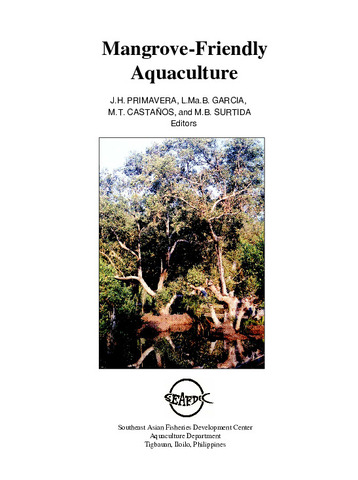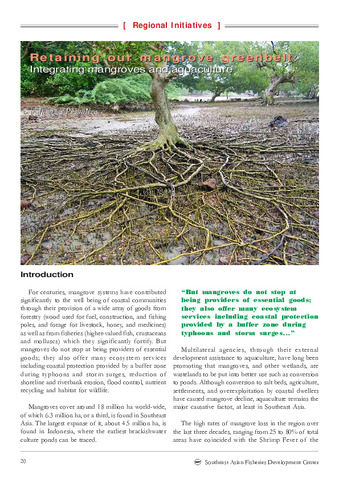A review of mangrove rehabilitation in the Philippines: successes, failures and future prospects
| dc.contributor.author | Primavera, Jurgenne | |
| dc.contributor.author | Esteban, J. M. A. | |
| dc.date.accessioned | 2011-06-01T08:32:06Z | |
| dc.date.available | 2011-06-01T08:32:06Z | |
| dc.date.issued | 2008 | |
| dc.identifier.citation | Primavera, J. H., & Esteban, J. M. A. (2008). A review of mangrove rehabilitation in the Philippines: successes, failures and future prospects. Wetlands Ecology and Management, 16(5), 345–358. | en |
| dc.identifier.issn | 0923-4861 | |
| dc.identifier.uri | http://hdl.handle.net/10862/93 | |
| dc.description | SEAFDEC main author. CC covered journal. Open Access Journal. Full text available. | en |
| dc.description.abstract | From half a million hectares at the turn of the century, Philippine mangroves have declined to only 120,000 ha while fish/shrimp culture ponds have increased to 232,000 ha. Mangrove replanting programs have thus been popular, from community initiatives (1930s-1950s) to government-sponsored projects (1970s) to large-scale international development assistance programs (1980s to present). Planting costs escalated from less than US$100 to over $500/ha, with half of the latter amount allocated to administration, supervision and project management. Despite heavy funds for massive rehabilitation of mangrove forests over the last two decades, the long-term survival rates of mangroves are generally low at 10-20%. Poor survival can be mainly traced to two factors: inappropriate species and sites selection. The favored but unsuitable Rhizophora are planted in sandy substrates of exposed coastlines instead of the natural colonizers Avicennia and Sonneratia. More significantly, planting sites are generally in the lower intertidal to subtidal zones where mangroves do not thrive rather than the optimal middle to upper intertidal levels, for a simple reason. Such ideal sites have long been converted to brackishwater fishponds whereas the former are open access areas with no ownership problems. The issue of pond ownership may be complex and difficult, but such should not outweigh ecological requirements: mangroves should be planted where fishponds are, not on seagrass beds and tidal flats where they never existed. This paper reviews eight mangrove initiatives in the Philippines and evaluates the biophysical and institutional factors behind success or failure. The authors recommend specific protocols (among them pushing for a 4:1 mangrove to pond ratio recommended for a healthy ecosystem) and wider policy directions to make mangrove rehabilitation in the country more effective. | en |
| dc.description.sponsorship | We thank Raul Roldan, Team Leader of the FRMP-Project Management Consultants and Regional Adviser for Region 4A, for contributing FRMP data;Veneracion Garcia, Charles Castro and the staff of the Department of Finance-CBRMP Project Management Office, for helping the junior author gather CBRMP data; and to Ann Melano (formerly of the Coastal Marine Management Office) for information on DENR mangrove reforestation efforts. Our appreciation also goes to Stanley Tan of MIMA, Malaysia for the invitation to the International Conference and Exhibition on Mangroves of Indian and Western Pacific Oceans held in Kuala Lumpur August 21–24, 2006, where an early version of this paper was presented. | en |
| dc.language.iso | en | en |
| dc.publisher | Springer | en |
| dc.subject | Community and local government initiatives | en |
| dc.subject | Avicennia | en |
| dc.subject | Rhizophora | en |
| dc.subject | Philippines | en |
| dc.subject | Mangrove nurseries | en |
| dc.subject | Pond ownership | en |
| dc.subject | International development assistance | en |
| dc.title | A review of mangrove rehabilitation in the Philippines: successes, failures and future prospects | en |
| dc.type | Article | en |
| dc.identifier.doi | 10.1007/s11273-008-9101-y | |
| dc.citation.volume | 16 | |
| dc.citation.issue | 5 | |
| dc.citation.spage | 345 | |
| dc.citation.epage | 358 | |
| dc.citation.journalTitle | Wetlands Ecology and Management | en |
| dc.subject.asfa | fish ponds | en |
| dc.subject.asfa | fishery policies | en |
| dc.subject.asfa | mangrove swamps | en |
| dc.subject.asfa | mangroves | en |
| dc.subject.asfa | property rights | en |
| dc.subject.asfa | sea grass | en |
| dc.subject.asfa | shrimp culture | en |
| dc.subject.asfa | tidal flats | en |
| dc.subject.asfa | wetlands | en |
| dc.subject.asfa | survival | en |
| dc.subject.scientificName | Sonneratia | en |
| dc.subject.scientificName | Avicennia marina | en |
| dc.subject.scientificName | Sonneratia alba | en |
Files in this item
| Files | Size | Format | View |
|---|---|---|---|
|
There are no files associated with this item. |
|||
This item appears in the following Collection(s)
-
Journal Articles [1258]
These papers were contributed by Department staff to various national and international journals.




